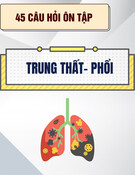
49
Journal of Medicine and Pharmacy, Volume 9, No.3/2019
EXTRACTION OPTIMIZATION AND ANTIOXIDANT ACTIVITY OF
PHENOLIC COMPOUNDS FROM AVOCADO PEEL
Ton Nu Linh Giang, Nguyen Thi Hoai, Vo Quoc Hung
Faculty of Pharmacy, Hue University of Medicine and Pharmacy, Hue University, Viet Nam
Abstract
Avocado peel has been considered as a potential source of natural antioxidants in which phenolics are
among the most important compounds. Therefore, this study aims to optimize the extraction process of
phenolics using response surface methodology and evaluate the corresponding antioxidant activity. From
the quadratic model, the optimal condition was determined including the ethanol concentration 54.55%
(v/v), the solvent/solute ratio 71.82/1 (mL/g), temperature 53.03 oC and extraction time 99.09 min. The total
phenolic content and the total antioxidant capacity at this condition with minor modifications were 26.74 ± 0.04
(mg GAE/g DW) and 188.06 ± 1.41 (mg AAE/g DW), respectively. The significant correlation between total
phenolic content and total antioxidant capacity was also confirmed.
Key words: response surface methodology, central composite rotatable design, total phenolic content,
total antioxidant capacity, avocado peel.
Corresponding author: Vo Quoc Hung, email: quochung2310@gmail.com DOI: 10.34071/jmp.2019.3.7
Received: 18/12/2018, Resived: 12/6/2019; Accepted: 15/6/2019
1. INTRODUCTION
Phenolic compounds occurring commonly in
plants and agricultural by-products have been seen
as important natural constituents since they possess
various biological effects such as anti-allergenic,
anti-artherogenic, anti-microbial, anti-inflammatory,
anti-thrombotic, cardioprotective and vasodilatory
activities [1]. Many of these effects are considered
to be related to their antioxidant activity through
different mechanisms, including reduction or
scavenging of reactive oxygen species, chelation
of transition metal ions, and inhibition of enzymes
involved in oxidative stress [2]. Therefore, much
attention has been focused on practical aspects of
phenolic extraction from agricultural wastes which
are effective and inexpensive sources of phenolic
antioxidants [3].
In the interest of seeking for a good source of
phenolic compounds from local agricultural by-
products, we collected several residual products
including avocado peels and seeds (Persea
americana Mill.), grapefruit peels (Citrus grandis (L.)
Osb. var. grandis), peanut shells (Arachis hypogaea
L.), mung bean (Vigna radiata (L.) R. Wilczek) and
cowpea (Vigna unguiculata Walp. subsp. cylindrica
(L.) Verdc.) seed pods, manihot stems (Manihot
esculenta Crantz), and the residual powder of
turmeric rhizomes (Curcuma longa L.) and elephant
yam corms (Amorphophallus paeoniifolius (Dennst.)
Nicolson). Our screening tests for total content of
phenolics have shown that avocado peel is one of the
richest sources of phenolics among the tested waste
products.
Avocado (Persea americana Mills.) belonging to
Lauraceae family is widely distributed in most of
the tropical and subtropical countries. This fruit is
rich in vitamins (C, B and E), potassium, dietary fiber
and unsaturated fatty acids such as oleic, linoleic
and α-linolenic acids which are highly beneficial to
human health. The mainly consumed part, however,
is the edible flesh of fresh fruits while other
avocado by-products, particularly peels, are usually
discarded, raising environmental concerns [4].
The avocado by-products generally showed
higher TPC than other fresh fruits, vegetables,
and plant extracts, described in the literature as
good sources of polyphenols. For instance, the
TPC of selected Mediterranean fruits and northern
berries ranged from 69 to 4604 mg GAE/100 g and
from 1190 to 5080 mg GAE/100 g, respectively,
whereas common vegetables such as beetroot and
carrots had between 40 and 740 mg GAE/100 g
[5]. Although avocado peel has been reported as a
potential antioxidant source with larger amounts of
phenolics, there have been insufficient data about
the optimization of extraction processes which can
be applied in practical aspect [4], [6].
The yield of chemical extraction usually depends
on many factors of the extraction process as well
as on the chemical composition and physical
characteristics of the samples [7]. Firstly, solvents
play a key role in the extraction process which






























